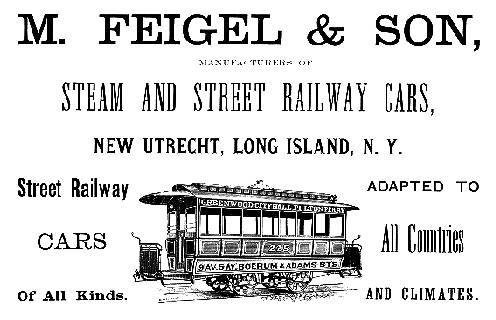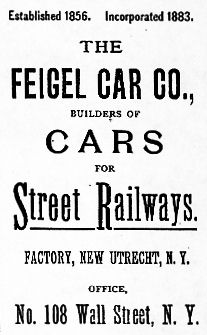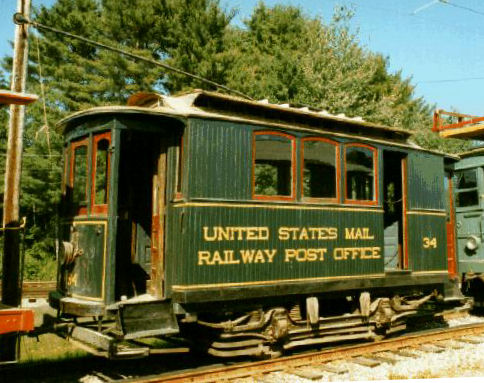Feigel Car CompanyM. Feigel & Son
Just how this wagon-builder began to build railway cars is unknown. One authority {379} suggests he began to build street railway [horse] cars on a speculative basis about 1870 as street railways began to spread throughout Brooklyn. This authority says —
According to one authority {379} Michael Feigel [Jr.] joined his father’s business about 1877, working as a salesman through the South and West. At that time Feigel employed 30 men. [One has to wonder just how far “South” and “West” 18-year-old Feigel went, as it appears virtually all known Feigel production went to lines within a few hundred miles of its factory.] When his son came of age in 1880, Michael Feigel made him a partner in the business, and the Feigel Car Works became M. Feigel & Son. {384}
By 1881, Feigel employed 40 men, and the plant was expanded. The next year, the product line was expanded to include building passenger cars for steam railroads. {379} In April 1883, M. Feigel & Son was incorporated as the Feigel Car Company, probably to expand ownership of the business and/or acquire new or additional capital. According to a news report of the time, {380} the incorporators were Michael Feigel Jr., William C. Baker and Frank L. Corwin, with themselves, Isaac Harris and Asa L. Rogers as trustees. Capital was to be $25,000 [roughly $0.5 million in today’s buying power] in 250 shares. The stated purpose of the company was “to manufacture and sell railway cars and other vehicles and agricultural implements.
The authority previously cited {379} quotes an article presumably appearing in the Coney Island newspaper, the Brighton Gazette, in September of 1883, describing the Feigel establishment, a portion of which follows —
It is clear from this and the rest of the quoted article that Feigel was—just as its articles of incorporation stated—building agricultural implements and horse-drawn vehicles of several different kinds as well as railway cars, (though Charlton {25} suggests “they produced probably more work cars than passenger cars”). In 1885, 27-year-old Michael Feigel Jr. died of tuberculosis after completing “a very successful business trip through Louisiana, Texas and California” [coughing all the way, one presumes]. The next year [1886] a business office was opened in New York City at 108 Wall Street. And the year after that [1887], Michael Feigel Sr. relinquished control of the business to John Hutton, foreman of the works, and R.C. Swann, who had replaced Michael Jr. as traveling agent. {381} Charlton {25} says that under the Hutton and Swann management, additional buildings were added to the New Utrecht works in 1887, but the 1887 edition of Poor's Directory of Railway Officials, in a section titled “Car Builders,” lists the corporate officers as Asa L. Rogers, President, William C. Baker, Treasurer, Frank L. Corwin, Secretary, with offices in New York (108 Wall Street), and Michael Feigel [Sr.], General Superintendent, New Utrecht, L.I. One is forced to ask, ‘Just who was in control?’ If Hutton & Swann ever were really “in control,” they must have quickly lost out to Asa L. Rogers, as is made manifest in the following incident which took place three years later. In an article titled “Rolling Stock of the Public Service Corporation of New Jersey and Its Predecessors,” {385} in a section titled “Newark & Irvington Street Railway Co.,” rail historian Harold E. Cox notes that this line began service 4 October 1890 with cars obtained through the A. L. Rogers Co., “an equipment broker which sold cars built by the Feigel Car Co.” and that “Rogers claimed to have a ‘New Utrecht Car Works’.” Of course he did: he was also President of the Feigel Car Company of New Utrecht! In 1891, Feigel produced the first electric streetcars in Galveston, Texas. Though Feigel’s advertisement above suggested a willingness to do export business, it appears the most distant order it filled was for the 10 horse cars it supplied the St. John (New Brunswick) City Railway Company in 1887. {386} As the fateful year of 1893 approached, business must have slowed considerably. Asa Rogers had apparently been buying lumber from the firm of Charles E. Rogers & Company, operated by his father-in-law of that name, for on 15 June 1892 three judgments for $6,345 were entered against the Feigel Car Company in favor of that corporation. {382} On 11 March of the next year, other creditors were in court demanding a Receiver be appointed for Feigel, because they had been offered 20 cents on the dollar by way of payment. It was alleged that most of the Feigel stock was owned by Charles E. Rogers & Company. {383} Within months, the stock market began the severe contraction that resulted in the 27 June 1893 crash. In the meantime, Charles E. Rogers & Company had changed its name to Rogers Manufacturing Company before itself going under, with assignment made to [who else?] Asa L. Rogers. Rogers Manufacturing is described as “dealers in lumber at 108 Wall Street,” the same address as the Feigel Car Company offices. {387} Coincidence? It is generally thought that Feigel ceased operations in 1894, {381} and that is supported by the evidence we have found. Feigel is included in the list of Car Builders in the second edition [1887] of Poor’s Directory of Railway Officials, and it is included in the Buyers Guide section of the 1893 edition, but it is not included in the Buyers Guide section of the 1895 edition. Only one Feigel car survives, and in a form almost unrecognizable. The Seashore Trolley Museum in Kennebunkport, Maine, has car #34, built in 1878 as a horse car for the New Bedford & Fairhaven Street Railway, electrified about 1894 with a power truck by the McGuire Manufacturing Company, and converted to a railway post office about 1902. Though greatly modified, it still retains its original “Bombay-full-monitor” roof.
Cast of Characters —Michael Feigel [Sr.] (c1829/30-1880+) was born in the part of central Europe then known as Hesse and now a part of Germany. He emigrated to the United States as a young man, settling at New Utrecht, a then-rural section of Long Island that would become Brooklyn, where he married about 1855. In 1856, he set up shop as a wheelwright (wagon-builder). Michael Feigel [Jr.] (c1858/59-1885) was born at New Utrecht, New York. He probably completed an apprenticeship [usually of two years duration] before becoming, at age 18, a sales representative for his father’s budding Asa L. Rogers (1851- ) Civil War service Company K, 6th Regiment, US Infantry |


